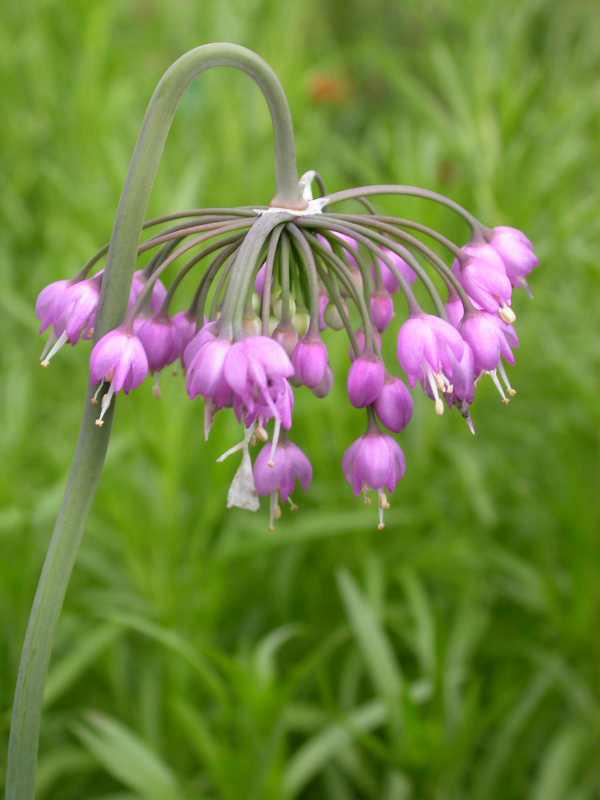
Sara Williams
Saskatchewan Perennial Society
Attractive, drought-tolerant, long-lived and trouble-free, alliums are among the most versatile yet underused hardy bulbs available to prairie gardeners. Most of the alliums grown in prairie gardens are from Asia, but there are over six hundred species worldwide, quite a few of which are adapted to our conditions.
Don’t be put off because the foliage may smell of onions. Allium is from the Latin word for garlic, but they are also related to lilies.
Some of the flowers are fragrant and all are lovely. Colours include white, pink, yellow, red, purple and blue. Heights range from 25 to 90 cm (10-36 in.). Most are summer blooming.
Plant alliums in full sun on well-drained soil. Deadhead to avoid unwanted seedlings. They are well suited to perennial or mixed borders and rock gardens. And can be used in fresh or dried arrangements.
The aflatun onion (Allium aflatunense) has lilac-purple or light violet flowers with darker veins. The flowers are drumstick in shape, 6 to 10 cm (2.5-4 in.) in diameter and bloom in May and June. Native to Siberia and Turkestan, they are 45 to 75 cm (17-30 in.) in height, with strap-shaped leaves. ‘Purple Sensation’ has bright purple flowers, 10 cm (4 in.) in diameter, and bloom in early summer on 90 cm (36 in.) stems. ‘Mount Everest’ has with white flowers on 60 cm (24 in.) stems. ‘Lucille Ball’ (A. aflatunense x A. elatum) is deep lilac and 100 cm (40 in.) in height with flower heads of 12-15 cm (5-6 in.).
The blue globe or azure onion (A. caeruleum, formerly A. azureum) has deep blue, globular flowers with darker central veins. These are alluded to by the former species name, azureum, which means dark blue. The flower heads are 3 to 4 cm (1–1.5 in.) in diameter, borne on 30 to 60 cm (12-24 in.) stems in June.
The nodding onion (A. cernuum) is native to gravelly and rocky areas of the prairies. Thirty to 60 cm (12–24 in.) in height, it has pink to white flowers in a loose, nodding head and blooms in summer. The foliage is grey green and somewhat flattened.
The yellow onion (A. flavum) has graceful, sweetly scented, lemon-yellow florets which form the umbel and are tier-like in effect, with the centre ones erect and the outer ones falling. It is 40 cm (16 in.) tall, blooming in late summer. The foliage is grey blue. It is native to the dry hills of central Europe and Asia.
The Turkestan onion (A. karataviens), named after a mountain range in Kazakhstan, is short-stemmed and only 25 cm (10 in.) high but has one of the larger flower heads of the hardy onions. The spherical, pale pink or purple flower heads, which are composed of star-shaped florets and bloom in early spring, are 7 to 10 cm (3-4 in.) in diameter. The two to three broad basal leaves are grey purple and held almost horizontally. ‘Ivory Queen’ is a selection with ivory-white flowers.
Golden garlic (A. moly) has star-like, buttercup-yellow flowers in early spring on 30 cm (12 in.) stems held above wide, grey-green basal leaves. In Europe, its native habitat, it is found in shaded areas on rock and gravel.
The Ostrowsky onion (A. oreophilum, formerly A. ostrowskianum,), has carmine pink flowers on 15 to 20 cm (6-8 in.) stems in midsummer above graceful, curled leaves. Oreophilum means mountain-loving; it is native to the Caucasus Mountains and Turkey into Iran and Afghanistan. ‘Zwanenburg’ is a deeper pink.
Chives (A. schoenoprasum) forms dense clumps, 30 to 45 cm (12-18 in.) high, with pink flowers 2 to 5 cm (1-2 in.) in diameter for much of the summer. ‘Forescate’ has deeper pink flowers.
Mountain garlic (A. senescens) has small, mauve-lilac flowers on 45 to 60 cm (18-24 in.) stems above glossy blue-grey leaves in late summer. It is native to Europe and Asia. A. senescens var. glauca has particularly attractive foliage, blue-grey and appealingly twisting.
Roundheaded leek (A. sphaerocephalon) is native to Europe, Asia and North Africa. It has drumstick-shaped flowers the colour of red wine that bloom in midsummer on 60 cm (24 in.) stems above narrow, hollow leaves.
This column is provided courtesy of the Saskatchewan Perennial Society (SPS; saskperennial@hotmail.com). Check our website (www.saskperennial.ca) or Facebook page (www.facebook.com/saskperennial) for a list of upcoming gardening events.

